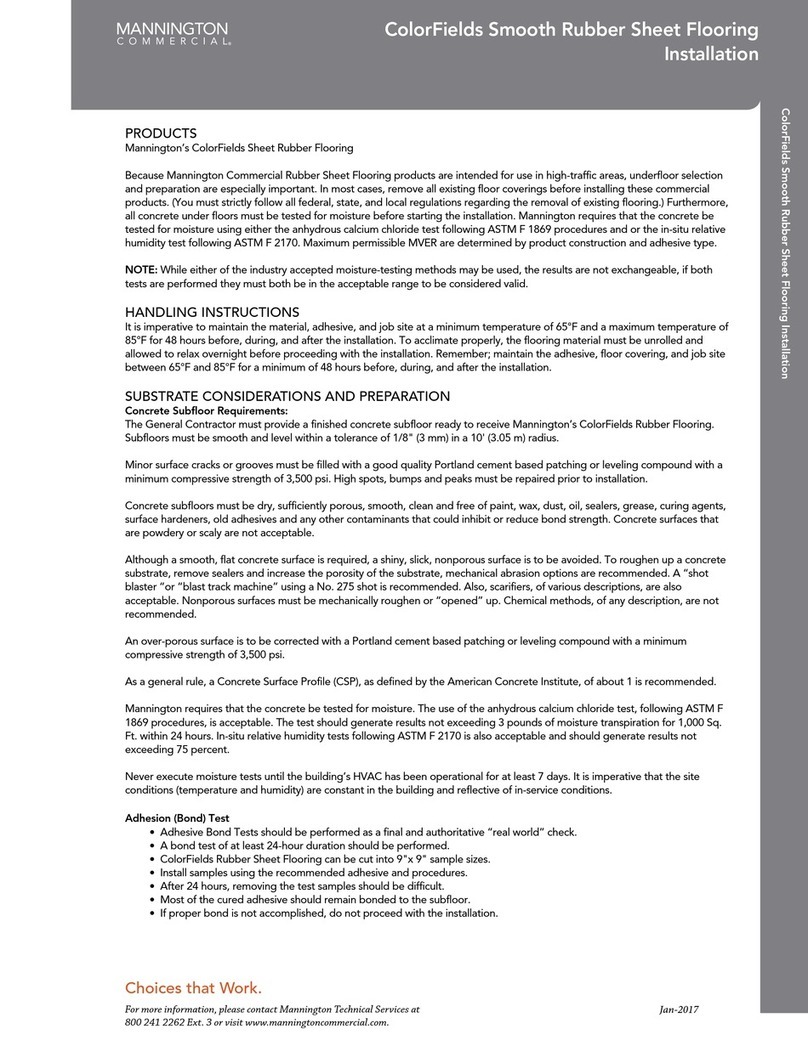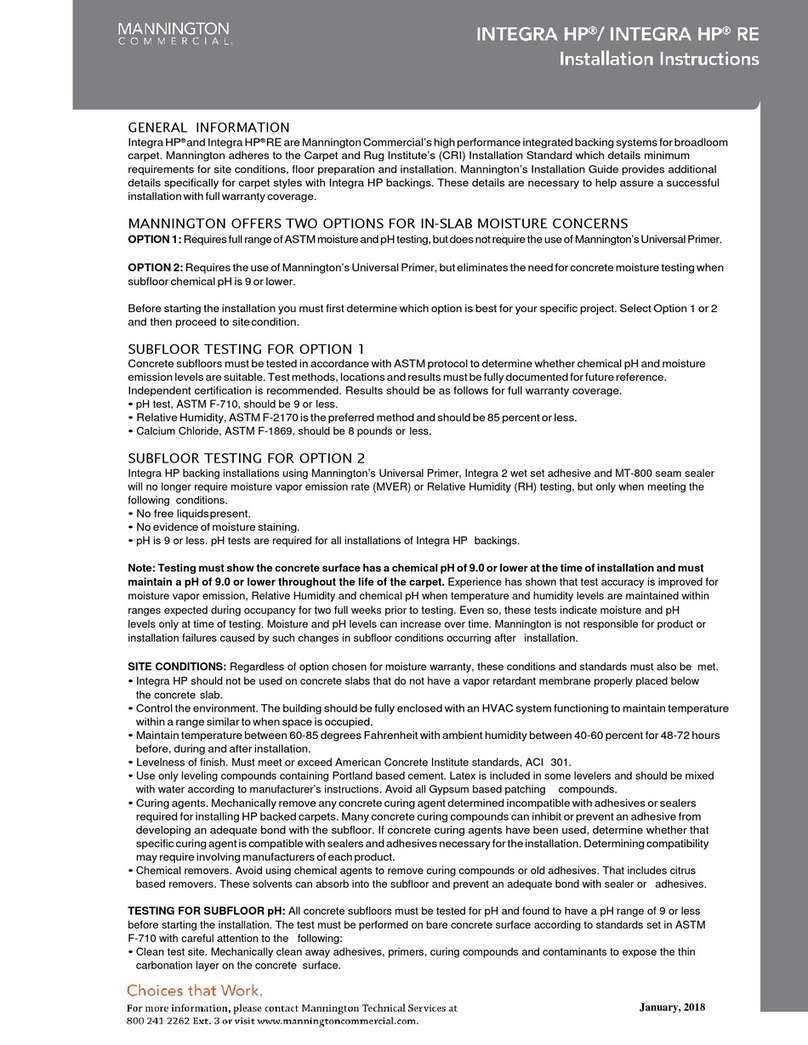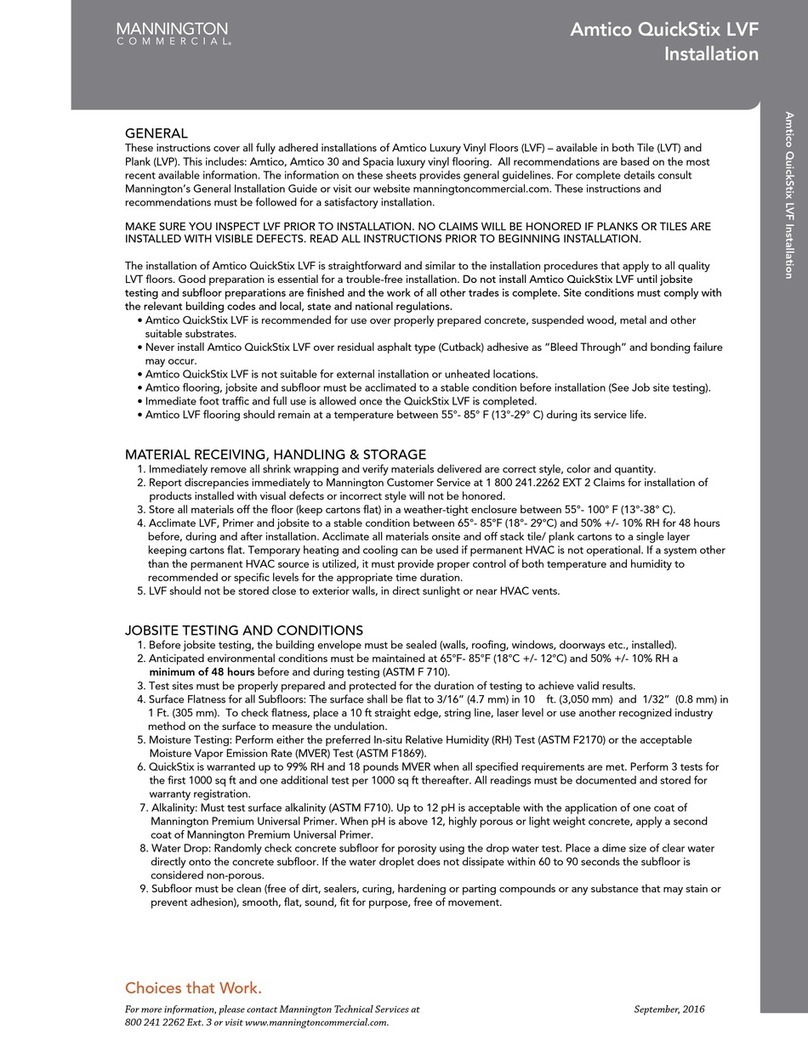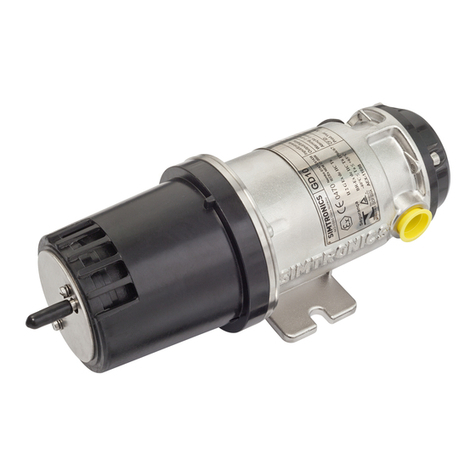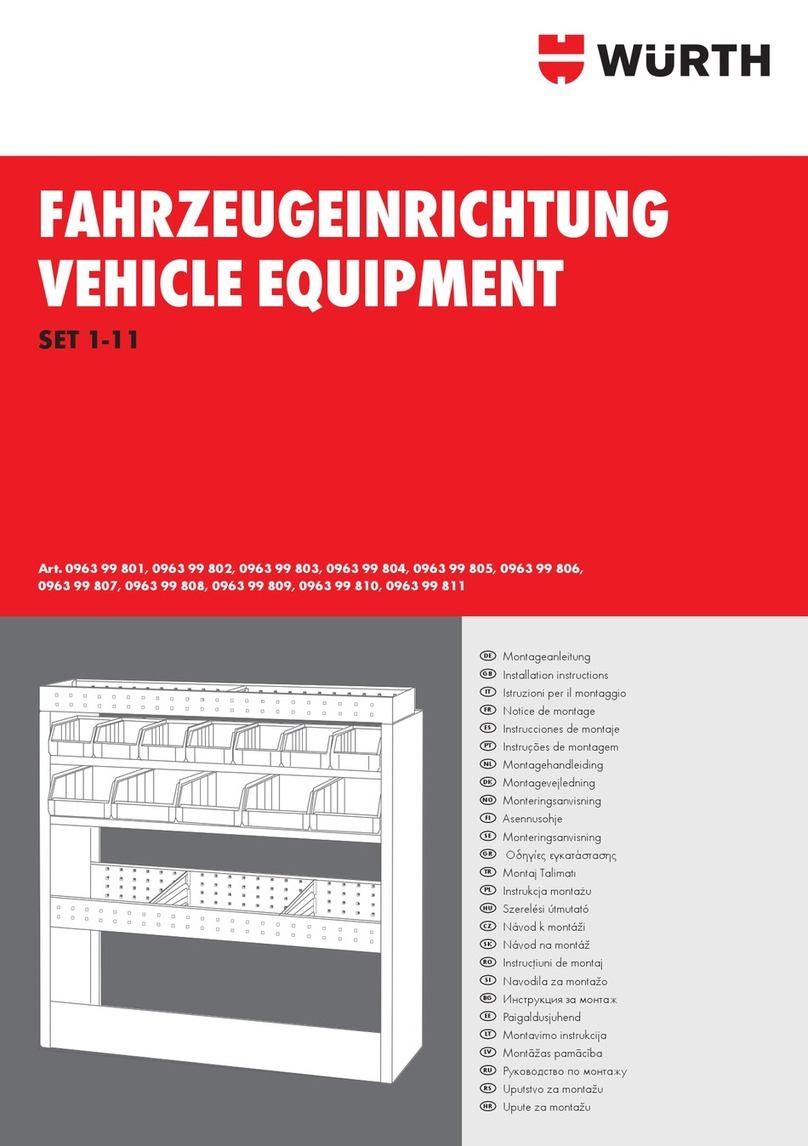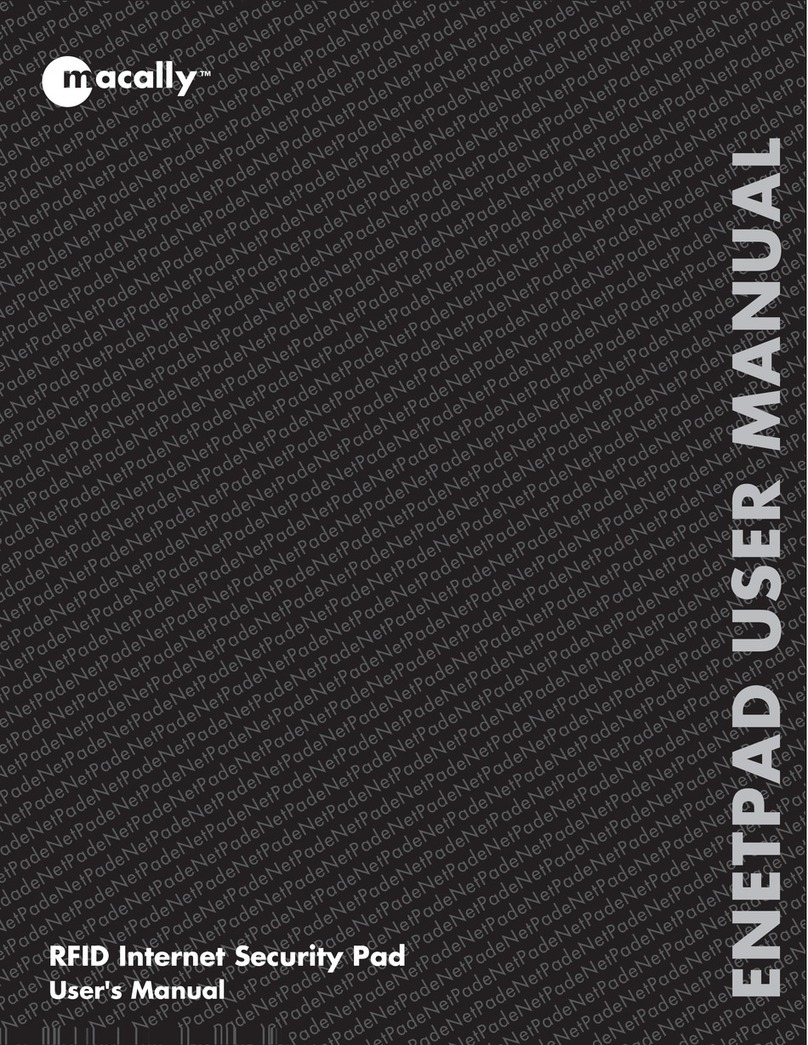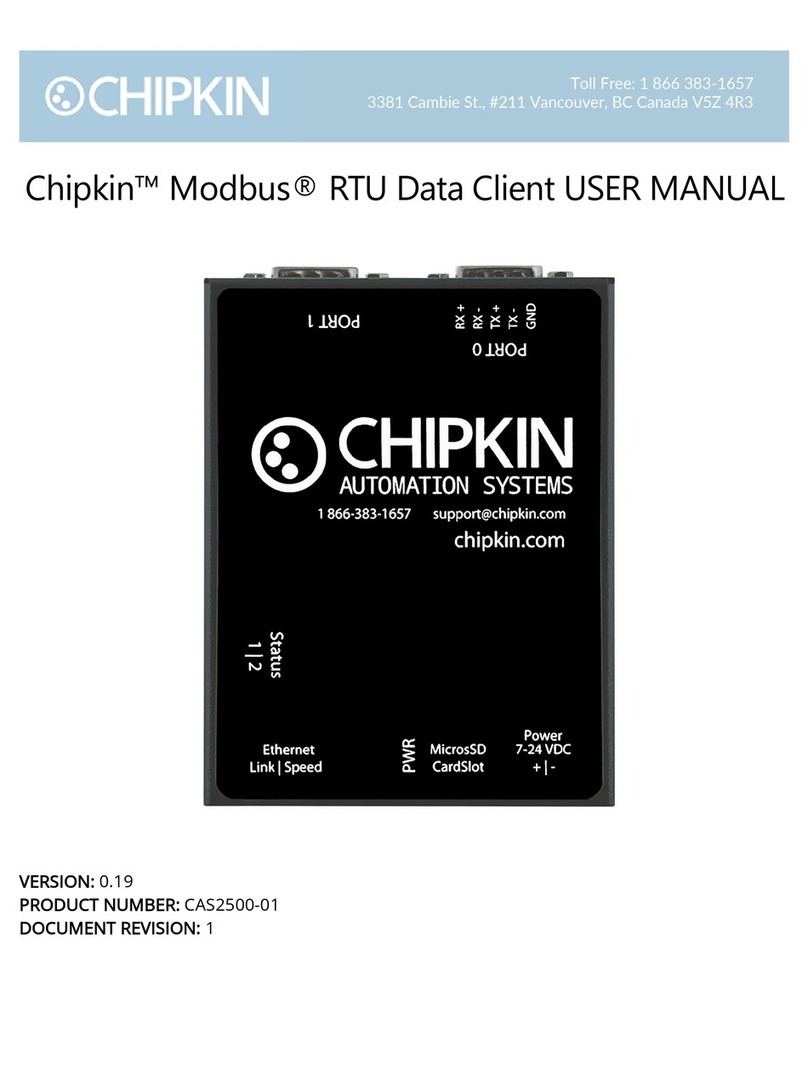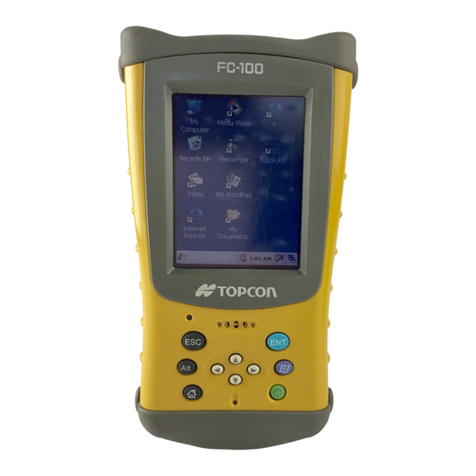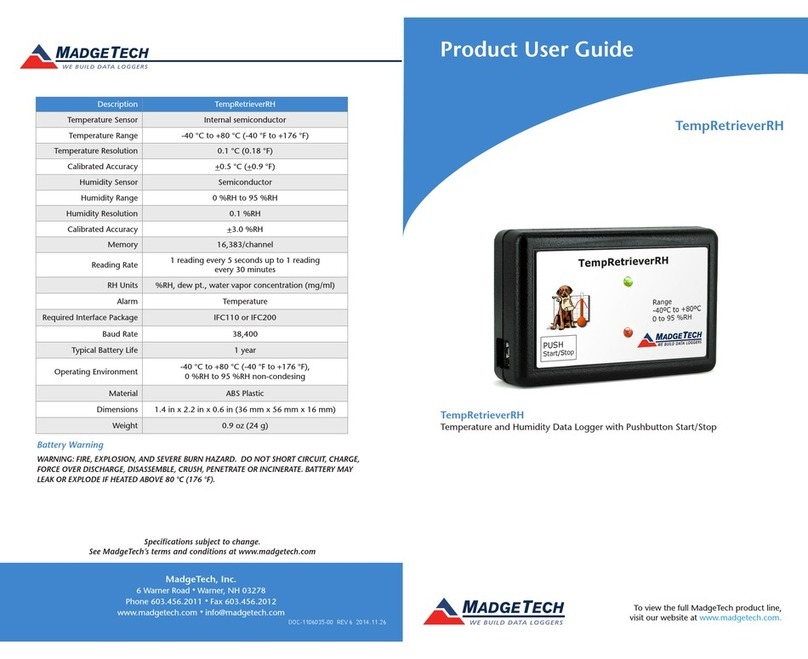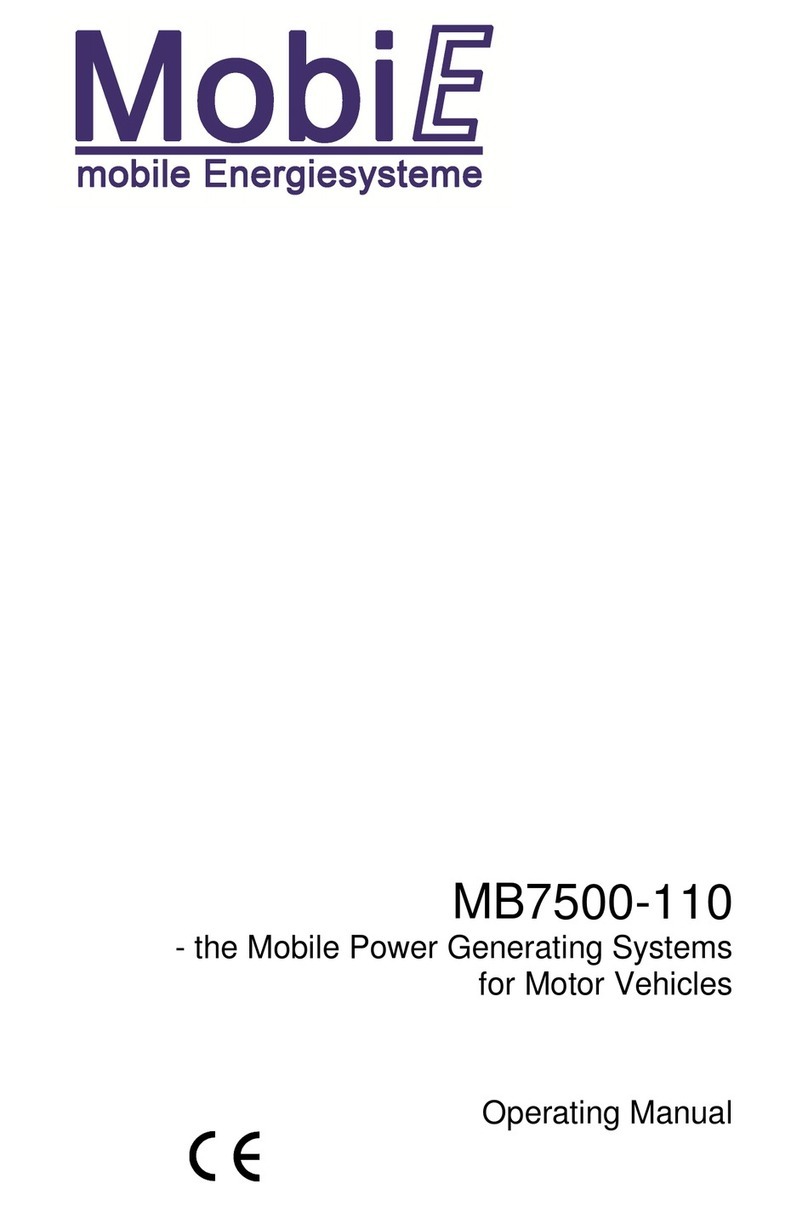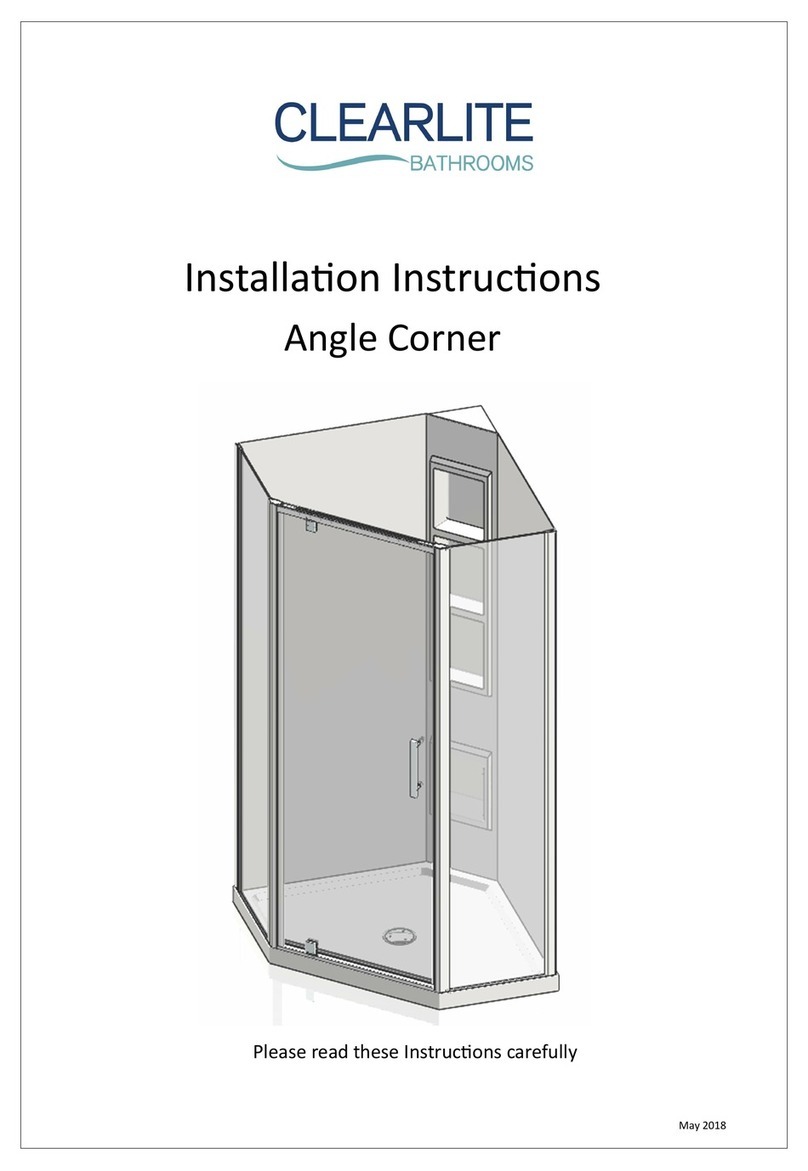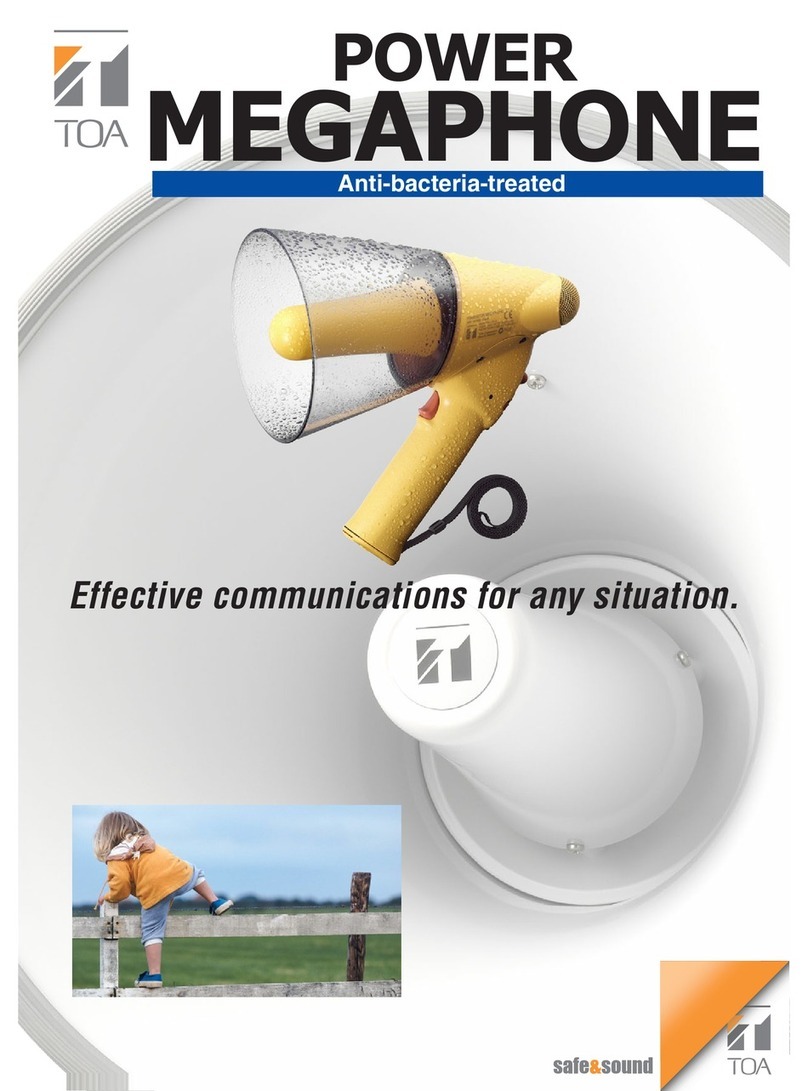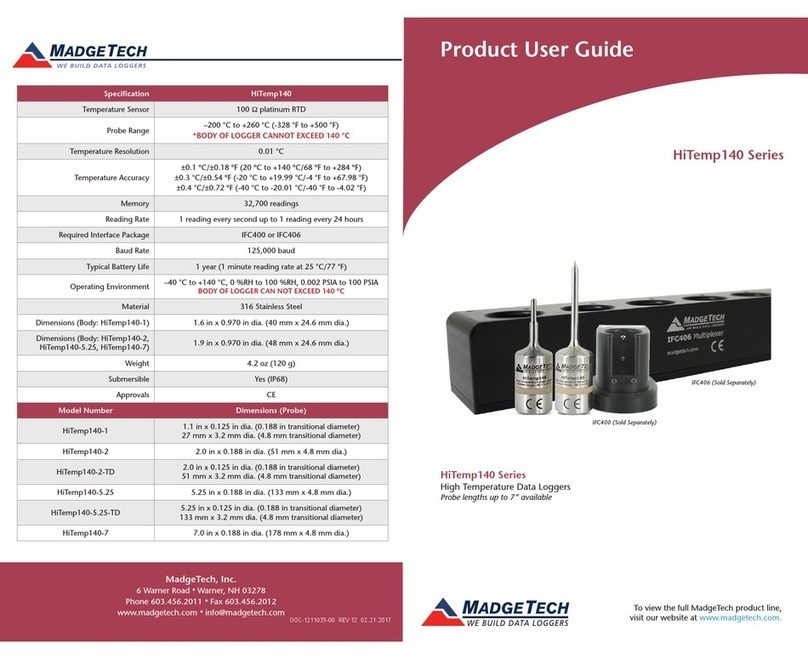Mannington commercial Amtico User manual

Installation Guidelines
11/18page 1 of 7 For more information, contact your local Mannington representative or visit manningtoncommercial.com
Crafted with purpose
GENERAL INFORMATION
Contact Mannington Technical Services for guidance about subfloor testing and installation recommendations.
Technical Services can be reached Monday to Friday, 8:00 a.m. to 5:00 p.m. EST at 800.241.2262 ext 3.
These instructions cover all fully adhered installations of Mannington Commercial Luxury Vinyl Floors (LVF) – this
includes both Tile (LVT) and Plank (LVP). This includes: Amtico, Amtico 30, Spacia and Spacia First. All recommendations
are based on the most recent available information. The information on these sheets provides general guidelines. For
complete details consult Mannington’s General Installation Guide or visit our website at manningtoncommercial.com.
These instructions and recommendations must be followed for a satisfactory installation.
The installation of Mannington LVF is straightforward and similar to the installation procedures that apply to all quality
resilient floors. Good preparation is essential for a trouble-free installation. Do not install Mannington LVF until job-site
testing and subfloor preparations are finished and the work of all other trades is complete. Site conditions must comply
with the relevant building codes and local, state and national regulations.
• Mannington LVF is recommended for use over properly prepared concrete, suspended wood, metal and other suitable
substrates. Never install Mannington LVF over residual asphalt type (Cutback) adhesive as “Bleed Through” may
occur.
• Mannington LVF is not suitable for external installation or unheated locations.
• Mannington flooring, adhesive, job-site and subfloor must be acclimated to a stable condition before installation.
(See Job-site Testing).
• Following installation, Mannington LVF foot traffic should be minimized for 24 hours; point loads and rolling traffic
should be minimized for 48 hours, and utilize minimal wet cleaning for 5 days (except XpressStep).
• Mannington LVF flooring should remain at a temperature between 55°-85°F (13°-29°C) during its service life.
• Adhesive types can have a significantly different moisture tolerance which can influence required subfloor prep as
well as install time.
MATERIAL RECEIVING, HANDLING & STORAGE
1. All floor covering products require care during storage and handling. It is important to store flooring products in a dry,
temperature-controlled interior area.
2. The temperature range should be between 65°-100°F, and the relative humidity should be controlled and maintained
between 30-70%.
3. Material must be conditioned for at least 48 hours before beginning the installation.
4. Flooring materials that are shipped in cartons must also be stored properly. Cartons must be kept squarely
positioned on the pallet to prevent distortion of the contents and to be fully supported. Do not store close to exterior
walls, in direct sunlight or near HVAC vents.
5. Stored cartons are to be protected from forklift and other traffic that can damage carton corners. Never double-
stack pallets of flooring products.
6. Immediately remove all shrink wrapping before acclimation and verify materials delivered are correct style, color and
quantity.
Amtico, Amtico 30, Spacia & Spacia First Luxury Vinyl Flooring
Installation Guidelines

Installation Guidelines
11/18page 2 of 7 For more information, contact your local Mannington representative or visit manningtoncommercial.com
Crafted with purpose
7. Report discrepancies immediately to Mannington at 800.241.2262 ext. 2 (Claims), as installation of products installed
with visual defects, mixed production runs or incorrect style will not be honored.
JOB-SITE TESTING
1. Before job-site testing, the building envelope must be sealed (walls, roofing, windows, doorways etc., installed).
2. The installation area and materials to be installed shall be maintained at a minimum of 65°F (18.3°C) and a maximum
of 85°F (29.4°C) for 48 hours before, during and for 48 hours after completion of the installation. Relative humidity
level extremes should also be avoided. General recommended humidity control level is between 35–55%. If a system
other than the permanent HVAC source is utilized, it must provide proper control of both temperature and humidity to
recommended or specific levels for the appropriate time duration.
3. Test sites must be properly prepared and protected for the duration of testing to achieve valid results.
4. Surface flatness for all subfloors: The surface shall be flat to 3/16” (3.9mm) in 10 ft. (3050 mm) and 1/32” (0.8 mm) in 1 ft.
(305 mm) To check flatness, place a 10-ft. straight edge, string, laser level or use another suitable method on the
surface, and measure the gap.
5. Concrete subfloors:
• Concrete subfloors must be finished, cured, and free of all sealers, coatings, finishes, dirt, film-forming curing
compounds or other substances that may prevent proper bonding of the flooring materials (ACI 302.1 and ASTM
F710).
• Randomly check concrete subfloor for porosity using the drop water test. Place a 1”-diameter drop of water
directly onto the concrete subfloor. If the water droplet does not dissipate within 60 to 90 seconds, the subfloor is
considered non-porous.
• Concrete subfloors must have a minimum compressive strength of 3000 psi. Concrete subfloors shall not consist
of lightweight concrete or gypsum.
• Moisture testing: Perform either the preferred In-situ Relative Humidity (RH) Test (ASTM F2170) or the acceptable
Moisture Vapor Emission Rate (MVER) Test (ASTM F1869). For acceptable moisture limits please refer to the
specifications of the adhesive of choice.
• Alkalinity: You must test surface alkalinity (pH) as per ASTM F710.
6. Wood subfloors and underlayment panels shall have the moisture content tested using a suitable wood pin meter.
Readings between the wood subfloor and underlayment should be within 3% and have a maximum moisture content
of 14% or less.
MOISTURE SUPPRESSANT SYSTEM
Concrete subfloors that exceed adhesive specifications will require a Moisture Suppressant System. Due to complexities
associated with moisture vapor transmission, emissions and movement of soluble salts (alkalinity) in concrete subfloors,
we do not offer, recommend or warranty a specific solution for excess moisture in concrete slabs. However, there are
many companies that offer solutions with warranties for excess moisture in concrete slabs.
Mannington Commercial suggests that you reference the current ASTM F710, “Standard Practice for Preparing Concrete
Floors to Receive Resilient Flooring,” and ASTM F3010, “Standard Practice for Two Component Resin Based Membrane
Forming Moisture Mitigation Systems for Use Under Resilient Flooring Systems.” Contact one or more of the following or
other moisture suppressant system suppliers for assistance:
Ardex: 724.203.5000, www.ardex.com
Koester American Corp.: 757.425.1206, www.koesterusa.com
Mapei: 800.426.2734, www.mapei.com
Schonox: 855.391.2649, www.hpsubfloors.com
Uzin: 800.505.4810, www.ufloorsystems.com

Installation Guidelines
11/18page 3 of 7 For more information, contact your local Mannington representative or visit manningtoncommercial.com
Crafted with purpose Mannington
COMMERCIAL
SUBFLOOR PREPARATION
Concrete
Careful subfloor preparation is vital for an excellent floor appearance and good tile/plank adhesion. The subfloor must
be smooth, firm, flat, clean, dry, free from defects and fit for purpose. A suitable smoothing compound should be used
to ensure that no irregularities show through to the surface of the finished floor. In all cases, the subfloor must meet the
moisture and pH requirements before installation.
Below and on-grade concrete subfloors must have a suitable vapor retarder properly installed directly beneath the
slab. Always follow manufacturer’s written recommendations for the use and installation of their appropriate surface
preparation materials.
1. Record and file site conditions, test results and any corrective action(s) taken. It is important to maintain this
documentation throughout the warranty period.
2. Subfloor must be clean (free of dirt, sealers, curing, hardening or parting compounds or any substance that may
stain or prevent adhesion), smooth, flat, sound, fit for purpose and free of movement, excessive moisture and high
alkalinity.
3. Slick surfaces such as power-troweled concrete shall be abraded or profiled to allow for a mechanical bond between
the adhesive and subfloor.
4. Remove existing resilient floor covering; remove all residual adhesive, paint or other contaminants following RFCI
recommended work practice. The use of adhesive removers or solvents in the abatement or removal of existing or old
adhesives is prohibited and may void any warranty.
WARNING: ASBESTOS & SILICA - Refer to the current Resilient Floor Covering Institute (RFCI) document
“Recommended Work Practices for Removal of Existing Resilient Floor Coverings” for guidance (www.RFCI.com).
5. Perform corrective actions necessary for elevated moisture or high alkalinity conditions.
6. Surface flatness for all subfloors: The surface shall be flat to 3/16” (3.9 mm) in 10 ft. (3050 mm) and 1/32” (0.8 mm)
in 1 ft. (305 mm). Bring high spots level by sanding, grinding etc. and fill low spots. Smooth surface to prevent any
irregularities or roughness from telegraphing through the new flooring.
7. Leveling and patching: For concrete subfloors, use only high quality Portland cement-based materials (minimum
3000 psi compressive strength according to ASTM C109 or ACI). Mix with water only; do not use latex. Caution: Do
not lightly skim coat highly polished or slick power-troweled concrete surfaces. A thin film of floor patch will not bond
to a slick subfloor and may become a bond breaker, causing flooring to release at the interface of the subfloor and
patching material. If in doubt, perform a bond test prior to commencing with the installation.
Wood
1. Wood subfloors require an underlayment (double layer construction) with a minimum total thickness of 1” (25
mm). Use minimum 1⁄4” (6 mm) thick APA rated “underlayment grade” plywood with a fully sanded face, or other
underlayment panel that is appropriate for the intended usage. Install and prepare panels and seams according
to the manufacturer’s instructions. Also refer to ASTM F1482, “Standard Practice for Installation and Preparation of
Panel Underlayments to Receive Resilient Flooring.”
2. Many times, wood panel subfloors are damaged during the construction process or are not underlayment grade.
These panels must be covered with an appropriate underlayment. Underlayment panels are intended to be used to
provide a smooth surface on which to adhere the finished floor covering. It should be understood that underlayment
panels cannot correct structural deficiencies.

Installation Guidelines
11/18page 4 of 7 For more information, contact your local Mannington representative or visit manningtoncommercial.com
Crafted with purpose Mannington
COMMERCIAL
3. Panels intended to be used as underlayment should be specifically designed for this purpose. These panels should
have a minimum thickness of 1⁄4” (6 mm). Any panels selected as an underlayment must meet the following criteria:
• Be dimensionally stable
• Have a smooth, fully sanded face, so graining or texture will not telegraph through
• Be resistant to both static and impact indentation
• Be free of any surface components that may cause staining, such as plastic fillers, marking inks sealers, etc.
• Be of uniform density, porosity and thickness
• Have a written warranty for suitability and performance from the panel manufacturer, or have a history of
proven performance
4. Any unevenness at the joints between panels must be sanded to a level surface. Gaps between panels, hammer
indentations and all other surface irregularities must be filled and sanded.
5. Particleboard, chipboard, construction grade plywood, OSB, flake-board and wafer board are not recommended as
underlayments. All have inadequate uniformity, poor dimensional stability and variable surface porosity. Mannington
Commercial will not accept responsibility for adhered installation over these subfloors. In all cases, the underlayment
manufacturer or underlayment installer is responsible for all underlayment warranties.
INSTALLATION PROCEDURE
Before starting the Mannington Luxury Vinyl Flooring (LVF – LVT or LVP) installation, ensure the following are
satisfactorily completed:
1. Acclimation: The installation area and materials to be installed shall be maintained at a minimum of 65°F (18.3°C) and
a maximum of 85°F (29.4°C) for 48 hours before, during and for 48 hours after completion of the installation. Relative
humidity level extremes should also be avoided. General recommended humidity control level is between 35-55%. If
a system other than the permanent HVAC source is utilized, it must provide proper control of both temperature and
humidity to recommended or specific levels for the appropriate time duration.
2. Flooring materials: Check that the quantity of Mannington LVF and adhesive are sufficient for area to be installed.
Check material for visual defects before installation. Installation of flooring acknowledges acceptance of materials.
Report discrepancies immediately to Mannington at 800.241.2262 ext. 2 (Claims), as installation of products installed
with visual defects, mixed production runs or incorrect style will not be honored.
3. Expansion joints, isolation joints or other moving joints are incorporated into concrete floor slabs in order to
permit movement without causing random cracks in the concrete. These joints must be honored and not filled with
underlayment products or other materials, and floor coverings must not be laid over them. Expansion joint covering
systems should be detailed by the architect or engineer based upon intended usage and aesthetic considerations.
4. Surface cracks, grooves, depressions, control joints or other non-moving joints, and other irregularities shall be filled
or smoothed with high quality Portland cement-based patching or underlayment compound for filling or smoothing,
or both. Patching or underlayment compound shall be moisture, mildew, and alkali-resistant, and shall provide a
minimum of 3000 psi compressive strength after 28 days, when tested in accordance with ASTM C109 or ASTM C472,
whichever is appropriate.
5. Subfloor preparation: Make sure all surfaces to be covered are completely clean, dry and smooth and that all
necessary subfloor preparation has been properly completed and documented.
6. Inspect substrate: Perform final acceptance inspection of substrate.
7. Adjacent surfaces protection: Protect adjacent work areas and finish surfaces from damage during product
installation.
8. Flooring protection: Mannington LVF should be the last material installed to prevent other trades from disrupting the
installation and adhesive set-up or damaging the floor.
Start of flooring installation indicates acceptance of current subfloor conditions and full responsibility for completed
work.

Installation Guidelines
11/18page 5 of 7 For more information, contact your local Mannington representative or visit manningtoncommercial.com
Crafted with purpose
Layout
Mannington LVF comes in plank and tile formats. All products have arrows imprinted on the back. Lay all arrows
pointing in the same direction. Mannington LVF can be laid out to run either parallel or diagonal to the room or primary
wall.
• Tiles should be installed block or staggered; when quarter turned, arrows should alternate.
• Plank flooring should have end joints offset by at least 6” and staggered to create a random appearance that avoids
alignment of end joints. All arrows should point in the same direction.
The following conditions must be given consideration when determining how Mannington LVF will be installed:
1. The layout shall be specified by end user, architect or designer.
2. Establish center marks and determine start point to balance installation in room and have equal tile widths on
opposite sides of room. This can be facilitated by dry-laying tiles and marking base lines.
3. The room layout must be set up so that all flooring can be installed while staying off freshly installed tiles. This will
minimize tile shifting, adhesive displacement and wet adhesive from oozing up and getting onto the face of the
tiles. This can be accomplished by creating work zones outlined with chalk lines to spread adhesive aligned with
established base lines. Create work zones that are no wider than the installers’ comfortable arm reach and in
multiples of the tile width.
4. All installations: Spread only the amount of adhesive that can be covered within the working time specific to the
adhesive being used.
When all preparatory work is satisfactorily completed, including dry-fitting cut tiles (if applicable), proceed with
installation. Inspect each tile for visual defects before installing. Installation of the flooring implies acceptance of
materials.
Adhesives
Mannington adhesives are specifically formulated to be fully compatible with backings and chemistry and to maximize
the performance of Mannington products. Using substitutes or failing to use Mannington adhesives as recommended
can cut short product life and cause installation failure.
Mannington Commercial recommends the following adhesives for the installation of Commercial LVF. Only these
adhesives should be used. Other adhesives may not provide adequate performance and could result in a failure.
1. Amtico 373 Adhesive: Amtico 373 is a solvent-free, nonflammable, freeze/thaw stable acrylic latex adhesive. The
maximum moisture limits must be no greater than 5 lbs. MVER per ASTM F-1869 and/or 80% relative humidity per
ASTM F-2170 with a pH limit of 10. Amtico 373 can be used to install LVF over porous subfloors using a 1/16” x 1/16” x
1/16” square-notch trowel with an approximate spread rate of 150-180 sq. ft. per gallon, and over non-porous subfloors
using a 1/32” x 1/32” x 1/16” fine-notch trowel with an approximate spread rate of 200-240 sq. ft. per gallon. It should be
used as a semi wet-set adhesive. See adhesive spec and label for details.
2. Amtico High Moisture PS Adhesive: Moisture resistant transitional pressure sensitive adhesive recommended for
higher moisture tolerance of 12 lbs. maximum MVER per ASTM F-1869 and/or 99% relative humidity per ASTM F-2170
with a pH maximum limit of 12. The adhesive will not correct pre-existing moisture problems in older concrete
subfloors. Amtico High Moisture PS Adhesive can be used to install LVF over porous subfloors using a 1/16” x 1/32” x
1/32” U-notched trowel with an approximate spread rate of 250 sq. ft. per gallon, and over non-porous subfloors using
a 1/16” x 1/32” x 5/64” U-notched trowel with an approximate spread rate of 350 sq. ft. per gallon. For non- porous
subfloors, adhesive must dry completely. See adhesive spec and label for details.

Installation Guidelines
11/18page 6 of 7 For more information, contact your local Mannington representative or visit manningtoncommercial.com
Crafted with purpose
3. Amtico RP18: A solvent-free 1-component silane polymer-base adhesive. Moisture limits per ASTM F-1869 of 10 lbs.
maximum MVER and/or 95% relative humidity per ASTM F-2170 and a pH limit of 12. Amtico RP18 works well over
porous subfloors using a 1/16” x 1/32” x 1/32” U-notch trowel with an approximate spread rate of 250 sq. ft. per gallon
and non-porous subfloors using a 1/16” x 1/32” x 5/64” U-notch trowel with an approximate spread rate of 350 sq. ft.
per gallon. It is recommended for use in all areas subject to some heat and moisture variations, like what may be
found adjacent to sunny windows and bathrooms. Amtico RP18 must be used for installing LVF in wet areas such as
locker rooms and should also be used for areas with high point loads and direct sun exposure. See adhesive spec and
label for details.
4. XpressStep Spray Adhesive: Water based spray adhesive recommended for the installation of Mannington
Commercial LVF over porous and non-porous subfloors. Moisture limits are 10 lbs. maximum MVER or 95 % relative
humidity with a pH maximum limit of 11. Spread rate approximately 150-185 sq. ft. per can.
XpressStep Premium Spray Adhesive: Moisture limits are 10 lbs. MVER or 98% relative humidity with a pH maximum
limit of 12. Spread rate approximately 150-185 sq. ft. per can.
XpressStep Spray Adhesives may be used under hospital beds, operating room tables and heavy rolling loads.
Mannington Commercial will not assume responsibility for floor covering failure due to hydrostatic pressure or moisture
vapor emission. The final responsibility for determining if the concrete is dry enough for installation of the flooring
lies with the floor covering installer. The adhesives are designed to be moisture resistant to accommodate the water
of hydration contained in new slabs or initial mixing; they are not to be considered remedial solutions to concrete
subfloors with a history of moisture problems.
Important: Temperature directly affects adhesive working and setting times. Warmer temperatures shorten working
times and colder temperatures lengthen working times of adhesive. Follow instructions on container for proper
application.
Installation
Adhesive application: Follow the instructions on the adhesive labels.
1. Use a trowel with appropriate notch size. Do not use worn trowels (approximately 600 sq. ft. usage on concrete).
2. Spread adhesive evenly with proper trowel held at 60 degree angle, avoiding skips or voids and excessive adhesive
application.
3. Only spread sufficient adhesive that can be covered within the adhesive working time.
4. Tiles/planks must be placed into adhesive as specified (follow label directions).
5. Install rows to chalk line making sure tiles/planks are precisely aligned with chalk line and adjacent tiles.
6. Randomly check tiles/planks for complete coverage of adhesive onto back of tile, especially near the end of each
adhesive spread. If there is little or no adhesive transfer, or if the adhesive has flashed off or skinned over, adequate
bonding may not be possible. Scrape the flashed-off adhesive from the floor, and spread fresh adhesive.
7. If tiles/planks shift, use releasable masking tape diagonally over seams to keep tiles tight and aligned.
8. Wet-set application: Do not work on top of freshly installed flooring. This will minimize tile/plank shifting and adhesive
displacement, and prevent wet adhesive from oozing up and getting onto the surface of the new flooring.
9. The floor must be rolled in both directions using a 100-lb. 3-section roller. Roll floor as soon as conditions permit,
without the tiles/planks sliding or adhesive bleeding to the surface. Roll floor again, 90 degrees to the first direction,
within 1 hour. Adhesives should provide 100% uniform adhesive transfer (no visible trowel ridges) onto the back of the
tile/plank, and not cause adhesive to squeeze out between tiles/planks. Pressure Sensitive Adhesive will not transfer
100% to the backing of the tile/plank. Be sure not to exceed the 3 hour working time.
10.Clean excess adhesive as you install, before it is allowed to dry. Use a soapy, clean, soft cloth to remove wet excess
adhesive.

Installation Guidelines
11/18page 7 of 7 For more information, contact your local Mannington representative or visit manningtoncommercial.com
Crafted with purpose
11. Clean up all debris as you work.
12. Wait 24 hours for normal foot traffic and 48 hours for point and rolling loads after installation.
13.During first five days, minimize heavy wet cleaning to allow adhesive to fully set.
Special Considerations
1. Radiant heat: Mannington Commercial LVF can be installed over radiant heating (hydronic) systems. The maximum
temperature of the subfloor surface must not exceed 85°F. Before installing flooring products over newly constructed
radiant heating systems, operate the system at maximum capacity to force any residual moisture from the
cementitious topping of the radiant heating system. The system must be switched off for a minimum of 48 hours
before, during and 48 hours after flooring installation.
2. Direct sunlight: Installations in areas where there is heavy direct sunlight exposure for long periods of time should
utilize window treatments and/or utilize Amtico RP18 Adhesive in these areas.
3. Protecting new installations: New installations must be protected while the adhesive cures. Early foot traffic, point
or rolling loads can cause adhesive displacement or breaking of the bond between the adhesive and the tile or
substrate.
Maintenance Precautions & Safety Information
Effective maintenance includes promptly removing all spills and then thoroughly cleaning with a diluted neutral cleaner
or cleaner/maintainer solution. Failure to establish an effective routine maintenance program will not only detract from
the appearance of the floor but may shorten its useful life. For complete details refer to Mannington’s maintenance
guidelines.
Safety first: Before commencing work, put out signs or safety cones to warn that cleaning is in progress. A slippery floor
can cause accidents. Slipperiness can be caused by poor maintenance, surface contamination, spills or when the floor
is wet. All hard floors can be slippery when wet. Ensure the floor is clean and dry before resuming use. Use warning signs
in commercial areas when performing maintenance or cleaning spills.
This manual suits for next models
2
Table of contents
Other Mannington commercial Other manuals
